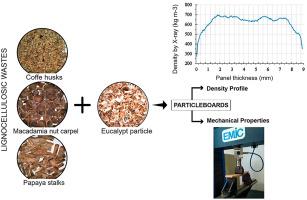Journal of Building Engineering ( IF 6.7 ) Pub Date : 2021-06-22 , DOI: 10.1016/j.jobe.2021.102903 Rhagnya Sharon Ferreira Martins , Fabricio Gomes Gonçalves , Pedro Gutemberg de Alcântara Segundinho , Roberto Carlos Costa Lelis , Juarez Benigno Paes , Yonny Martinez Lopez , Izabella Luzia Silva Chaves , Rafael Gonçalves Espósito de Oliveira

|
This study aimed to evaluate the effect of agro-industrial lignocellulosic wastes addition on the mechanical properties and density profile of particleboards made with eucalypt wood. Agro-industrial wastes as macadamia nut carpel, coffee husk and papaya stem were used in percentages of 10, 20 and 30 respectively, in the particleboard composition. The panels were produced by compression molding with nominal density of 700 kg m−3. Mechanical properties as modulus of rupture, modulus of elasticity, screw withdrawal resistance, internal bond and Janka hardness mechanical properties of particleboards bonded with urea-formaldehyde and 50% tannin solution of Acacia mearnsii with ratio of 90:10 resin were also determined. X-ray densitometry was used to study the density profile of the particleboards. In general, the mechanical properties of the particleboards contend agro-industrial waste were inferior to the control based on eucalypts wood. The density profile in some compositions suggests a homogeneous behavior, similar to the "M" format; however, the proportion of the wastes interferes in this format, without potentially compromising the internal bonding properties and Janka hardness. Although the particleboard for agro-industrial waste shows overall a reduced performance, it can be affirmed that 10% of the waste meets the requirements for particleboards of general use. Environmental gains are promising since inappropriate disposal would be avoided.
中文翻译:

建筑用刨花板制造中的农工业木质纤维素废物的调查
本研究旨在评估添加农工业木质纤维素废物对桉木制成的刨花板的机械性能和密度分布的影响。在刨花板组合物中,澳洲坚果心皮、咖啡壳和木瓜茎等农业工业废物的使用比例分别为 10、20 和 30。面板通过压缩成型生产,标称密度为 700 kg m -3。用脲甲醛和 50%金合欢单宁溶液粘合的刨花板的机械性能,如断裂模量、弹性模量、抗螺钉拔出力、内部粘合和 Janka 硬度机械性能树脂的比例为 90:10。X 射线密度测定法用于研究刨花板的密度分布。一般而言,刨花板的机械性能与基于桉树木材的控制物相比,认为农业工业废料较差。某些组合物中的密度分布表明具有同质性,类似于“M”格式;然而,废物的比例会干扰这种格式,而不会影响内部粘合性能和 Janka 硬度。虽然农工业废弃物刨花板的性能总体上有所下降,但可以肯定的是,10%的废弃物符合一般用途刨花板的要求。环境收益是有希望的,因为可以避免不当处置。











































 京公网安备 11010802027423号
京公网安备 11010802027423号